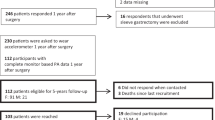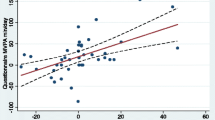Abstract
Purpose
The impact of regular exercises or physical activity (PA) on weight of bariatric patients need to be elucidated. We investigated PA levels, sedentary time (ST), and weight regain on these patients who were without regular medical follow-up before recruitment. Moreover, we investigated correlation and concordance between self-reported and objective measures in moderate-to-vigorous PA (MVPA) and ST.
Materials and Methods
We invited 132 patients previously subjected to a bariatric procedure to a medical appointment in our unit and proposed them to be volunteers. Ninety patients, aged 42 ± 8 years and BMI 32.9 ± 6.6 kg/m2, entered the study and were allocated into groups according to time since surgery < or ≥5 years (G5− or G5+, respectively). They were further assigned into low or high rates of weight regain (RWR; cutoff 20%). PA and ST were measured by International PA Questionnaire (IPAQ) and ActiGraph GT3X+ accelerometer.
Results
In G5- group, PA and ST were similar between low and high RWR. In G5+ group, MVPA time, number of steps/day, percent of patients somewhat active, and 30–60 min/day of MVPA were statistically higher in those with low RWR. Of note, measures of MVPA < 30 min/day occurred more frequently in those with high RWR. MVPA and ST self-reported vs. objective measures were correlated (P < 0.001). Nevertheless, there was no concordance between these measures (P > 0.05).
Conclusions
Low level of PA and longer ST occurred more frequently in those with high RWR and longer time since surgery. Although well-correlated, any concordance between IPAQ and accelerometer measures was noted.

Similar content being viewed by others
References
Reges O, Greenland P, Dicker D, et al. Association of bariatric surgery using laparoscopic banding, Roux-en-Y gastric bypass, or laparoscopic sleeve gastrectomy vs usual care obesity management with all-cause mortality. JAMA. 2018;319:279–90. Available from:. https://doi.org/10.1001/jama.2017.20513.
Adams TD, Gress RE, Smith SC, et al. Long-term mortality after gastric bypass surgery. N Engl J Med. 2007;357:753–61.
Karmali S, Brar B, Shi X, et al. Weight recidivism post-bariatric surgery: a systematic review. Obes Surg. 2013;23:1922–33. Available from:. https://doi.org/10.1007/s11695-013-1070-4.
Kushner RF, Sorensen KW. Prevention of weight regain following bariatric surgery. Curr Obes Rep. 2015;4:198–206.
Jakivic (Chair) JM, Clark K, Coleman E, et al. Appropriate intervention strategies for weight loss and prevention of weight regain for adults. Med Sci Sports Exerc. 2001;33 Available from: https://journals.lww.com/acsm-msse/Fulltext/2001/12000/Appropriate_Intervention_Strategies_for_Weight.26.aspx
Executive summary: Guidelines (2013) for the management of overweight and obesity in adults: a report of the American College of Cardiology/American Heart Association Task Force on Practice Guidelines and the Obesity Society published by the Obesity Soci. Obesity (Silver Spring). 2014;22 Suppl 2:S5–39.
Mechanick JI, Youdim A, Jones DB, Timothy Garvey W, Hurley DL, Molly McMahon M, et al. Clinical practice guidelines for the perioperative nutritional, metabolic, and nonsurgical support of the bariatric surgery patient - 2013 update: Cosponsored by American Association of Clinical Endocrinologists, the Obesity Society, and American Society. Surg Obes Relat Dis. Elsevier Inc.; 2013;9:159–91. Available from: https://doi.org/10.1016/j.soard.2012.12.010
Murai IH, Roschel H, Dantas WS, et al. Exercise mitigates bone loss in women with severe obesity after Roux-en-Y gastric bypass: a randomized controlled trial. J Clin Endocrinol Metab. 2019;104:4639–50.
Huck CJ. Effects of supervised resistance training on fitness and functional strength in patients succeeding bariatric surgery. J Strength Cond Res. 2015;29:589–95.
Dantas WS, Gil S, Murai IH, Costa-Hong V, Peçanha T, Merege-Filho CAA, et al. Reversal of improved endothelial function after bariatric surgery is mitigated by exercise training. J Am Coll Cardiol. American College of Cardiology Foundation; 2018;72:2278–9. Available from: https://doi.org/10.1016/j.jacc.2018.07.094
Castello V, Simões RP, Bassi D, et al. Impact of aerobic exercise training on heart rate variability and functional capacity in obese women after gastric bypass surgery. Obes Surg. 2011;21:1739–49.
Shah M, Snell PG, Rao S, Adams-Huet B, Quittner C, Livingston EH, et al. High-volume exercise program in obese bariatric surgery patients: a randomized, controlled trial. Obesity. Nature Publishing Group; 2011;19:1826–34. Available from: https://doi.org/10.1038/oby.2011.172/nature06264
Lee IM, Shiroma EJ, Lobelo F, Puska P, Blair SN, Katzmarzyk PT, et al. Effect of physical inactivity on major non-communicable diseases worldwide: an analysis of burden of disease and life expectancy. Lancet. Elsevier Ltd; 2012;380:219–29. Available from: https://doi.org/10.1016/S0140-6736(12)61031-9
Stamatakis E, Gale J, Bauman A, et al. Sitting time, physical activity, and risk of mortality in adults. J Am Coll Cardiol. 2019;73:2062–72.
Egberts K, Brown WA, Brennan L, et al. Does exercise improve weight loss after bariatric surgery? A systematic review. Obes Surg. 2012;22:335–41.
Welch G, Wesolowski C, Piepul B, et al. Physical activity predicts weight loss following gastric bypass surgery: findings from a support group survey. Obes Surg. 2008;18:517–24.
Lars Sjöström M et al. Lifestyle, diabetes, and cardiovascular risk factors 10 years after bariatric surgery. N Engl J Med. 2004;351:2683–93.
Berglind D, Willmer M, Tynelius P, et al. Accelerometer-measured versus self-reported physical activity levels and sedentary behavior in women before and 9 months after Roux-en-Y gastric bypass. Obes Surg. 2016;26:1463–70.
Bond DS, Jakicic JM, Unick JL, Vithiananthan S, Pohl D, Roye GD, et al. Pre- to postoperative physical activity changes in bariatric surgery patients: self report vs. objective measures. Obesity. Nature Publishing Group; 2010;18:2395–7. Available from: https://doi.org/10.1038/oby.2010.88
Sjöström CD, Lissner L, Wedel H, et al. Reduction in incidence of diabetes, hypertension and lipid disturbances after intentional weight loss induced by bariatric surgery: the SOS intervention study. Obes Res. 1999;7:477–84.
Pickering TG, Hall JE, Appel LJ, et al. Recommendations for blood pressure measurement in humans and experimental animals: part 1: blood pressure measurement in humans - a statement for professionals from the Subcommittee of Professional and Public Education of the American Heart Association Co. Circulation. 2005;111:697–716.
Craig CL, Marshall AL, Sjöström M, et al. International physical activity questionnaire: 12-country reliability and validity. Med Sci Sports Exerc. 2003;35:1381–95.
Troiano RP, Berrigan D, Dodd KW, et al. Physical activity in the United States measured by accelerometer. Med Sci Sports Exerc. 2008;40:181–8.
Tudor-Locke C, Hatano Y, Pangrazi RP, et al. Revisiting “how many steps are enough?”. Med Sci Sports Exerc. 2008;40:537–43.
Tudor-Locke C, Johnson WD, Katzmarzyk PT. Accelerometer-determined steps per day inus adults. Med Sci Sports Exerc. 2009;41:1384–91.
Guraya SY, Strate T. Effectiveness of laparoscopic Roux-en-Y gastric bypass and sleeve gastrectomy for morbid obesity in achieving weight loss outcomes. Int J Surg England. 2019;70:35–43.
Crisp AH, Verlengia R, Ravelli MN, et al. Changes in physical activities and body composition after roux-Y gastric bypass surgery. Obes Surg United States. 2018;28:1665–71.
Afshar S, Seymour K, Kelly SB, Woodcock S, van Hees VT, Mathers JC. Changes in physical activity after bariatric surgery: using objective and self-reported measures. Surg Obes Relat Dis. Elsevier; 2017;13:474–83. Available from: https://doi.org/10.1016/j.soard.2016.09.012
Berglind D, Willmer M, Eriksson U, et al. Longitudinal assessment of physical activity in women undergoing Roux-en-Y gastric bypass. Obes Surg. 2015;25:119–25.
Zabatiero J, Smith A, Hill K, et al. Do factors related to participation in physical activity change following restrictive bariatric surgery? A qualitative study. Obes Res Clin Pract. Netherlands. 2018;12:307–16.
Saint-Maurice PF, Troiano RP, Bassett DRJ, et al. Association of daily step count and step intensity with Mortality among US adults. JAMA. 2020;323:1151–60.
Possmark S, Sellberg F, Willmer M, et al. Accelerometer-measured versus self-reported physical activity levels in women before and up to 48 months after Roux-en-Y gastric bypass. BMC Surg. 2020;20:39.
Dikareva A, Harvey WJ, Cicchillitti MA, et al. Exploring perceptions of barriers, facilitators, and motivators to physical activity among female bariatric patients: implications for physical activity programming. Am J Health Promot. United States. 2016;30:536–44.
Raoof M, Szabo E, Karlsson J, et al. Improvements of health-related quality of life 5 years after gastric bypass. What is important besides weight loss? A study from Scandinavian Obesity Surgery Register. Surg Obes Relat Dis. 2020:1–9.
Stenmark Tullberg H, Fagevik Olsén M, Shams K, Wiklund M. “Stepping with ease towards a new way of living” – experiences of physical activity 5 years after bariatric surgery. Eur J Physiother. Taylor & Francis; 2017;19:154–9. Available from: https://doi.org/10.1080/21679169.2017.1326527
Funding
Coordination for the Improvement of Higher Education Personnel (CAPES), Brazilian Council for Technological and Scientific Development (CNPq), and Carlos Chagas Filho Foundation for the Research Support in the State of Rio de Janeiro (FAPERJ) supported this work.
Author information
Authors and Affiliations
Contributions
The original study design was made by LGK-A. The project administration and supervision were performed by LGK-A. ECR and KGL recruited the patients and collected the data. ECR, KGL, DMF, PF, and LGK analyzed the data, interpreted the results, and drafted and revised the manuscript. All authors approved the final version of the manuscript.
Corresponding author
Ethics declarations
Conflict of Interest
The authors declare that they have no conflict of interest.
Additional information
Publisher’s Note
Springer Nature remains neutral with regard to jurisdictional claims in published maps and institutional affiliations.
Rights and permissions
About this article
Cite this article
Romagna, E.C., Lopes, K.G., Mattos, D.M.F. et al. Physical Activity Level, Sedentary Time, and Weight Regain After Bariatric Surgery in Patients Without Regular Medical Follow-up: a Cross-Sectional Study. OBES SURG 31, 1705–1713 (2021). https://doi.org/10.1007/s11695-020-05184-x
Received:
Revised:
Accepted:
Published:
Issue Date:
DOI: https://doi.org/10.1007/s11695-020-05184-x




